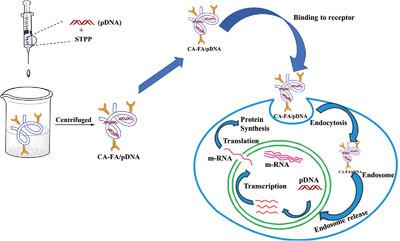当前位置:
X-MOL 学术
›
Biotechnol. Appl. Bioc.
›
论文详情
Our official English website, www.x-mol.net, welcomes your feedback! (Note: you will need to create a separate account there.)
Formulation of a pH‐sensitive cancer cell‐targeted gene delivery system based on folate–chitosan conjugated nanoparticles
Biotechnology and Applied Biochemistry ( IF 2.8 ) Pub Date : 2020-02-15 , DOI: 10.1002/bab.1900 Reza Mohammadzadeh 1 , Parinaz Shahim 1 , Ali Akbari 2
Biotechnology and Applied Biochemistry ( IF 2.8 ) Pub Date : 2020-02-15 , DOI: 10.1002/bab.1900 Reza Mohammadzadeh 1 , Parinaz Shahim 1 , Ali Akbari 2
Affiliation

|
In this study, we investigated the design and construct of a chitosan (CA)‐based targeted gene delivery system and evaluated its function. To this end, CA–folic acid/pDNA (CA–FA/pDNA) nanoparticles were prepared in different formulations using the ion gelation method. All the synthesized nanoparticles were characterized using FTIR, TEM, SEM and DLS. Moreover, the effects of molecular weight (MW) of CA, DNA, and CA concentration were inspected on encapsulation efficiency (EE). The results showed that the EE of pDNA was directly proportional with MW of CA and CA concentration but was in an inverse proportion with DNA concentration. In addition, high MW of CA and low MW of CA nanoparticles showed lower and higher pDNA release in all pH ranges, respectively. It is concluded that the N/P ratio increase can cause controlled pDNA release.
中文翻译:

基于叶酸-壳聚糖共轭纳米粒子的pH敏感癌细胞靶向基因传递系统的构建
在这项研究中,我们调查了基于壳聚糖(CA)的靶向基因递送系统的设计和构建,并评估了其功能。为此,使用离子凝胶法以不同的配方制备了CA-叶酸/ pDNA(CA-FA / pDNA)纳米颗粒。使用FTIR,TEM,SEM和DLS对所有合成的纳米颗粒进行表征。此外,检查了CA的分子量(MW),DNA和CA浓度对包封效率(EE)的影响。结果表明,pDNA的EE与CA的分子量和CA浓度成正比,而与DNA浓度成反比。此外,高分子量的CA和低分子量的CA纳米颗粒分别在所有pH范围内显示出较低和较高的pDNA释放。结论是N / P比的增加可以引起受控的pDNA释放。
更新日期:2020-02-15
中文翻译:

基于叶酸-壳聚糖共轭纳米粒子的pH敏感癌细胞靶向基因传递系统的构建
在这项研究中,我们调查了基于壳聚糖(CA)的靶向基因递送系统的设计和构建,并评估了其功能。为此,使用离子凝胶法以不同的配方制备了CA-叶酸/ pDNA(CA-FA / pDNA)纳米颗粒。使用FTIR,TEM,SEM和DLS对所有合成的纳米颗粒进行表征。此外,检查了CA的分子量(MW),DNA和CA浓度对包封效率(EE)的影响。结果表明,pDNA的EE与CA的分子量和CA浓度成正比,而与DNA浓度成反比。此外,高分子量的CA和低分子量的CA纳米颗粒分别在所有pH范围内显示出较低和较高的pDNA释放。结论是N / P比的增加可以引起受控的pDNA释放。


























 京公网安备 11010802027423号
京公网安备 11010802027423号